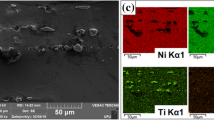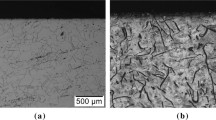Abstract
In the aeronautical industry, many components are subjected to abrasive machining processes to ensure surface integrity. However, many of these components are manufactured from titanium alloys, such as the Ti-6Al-4V alloy, which is considered a difficult material to machine due to its low thermal conductivity, high mechanical strength, and chemical reactivity with ceramic materials. As dressing one of major factors governing grinding, the proper selection of dressing parameters for the abrasive wheel is crucial for the surface quality of difficult-to-machine materials as well as the loading of the abrasive wheel. In this sense, the present work aimed to evaluate the effects of different dressing conditions of a SiC grinding wheel on the surface integrity of the Ti-6Al-4V alloy. A fliesen dresser, two different overlap ratio values (Ud = 3 and Ud = 12), and two depth of dressing cuts (ad = 20 µm and ad = 40 µm) were employed in the experiments. From the analysis of the results, it was verified that the change in the grinding wheel conditioning from an aggressive dressing (Ud = 3 and ad = 40 µm) to a soft dressing condition (Ud = 12 and ad = 20 µm) generated a drop of 53.74% in the roughness values, oriented grooves on the ground surface, reduction in thermal dams below the grinding interface, and an increase of 65.93% in the G ratio. Therefore, the results showed that the change in the conditioning of the SiC grinding wheel through the dressing can improve Ti-6Al-4V alloy grindability.











Similar content being viewed by others
References
Mierzejewska ZA, Hudák R, Sidun J (2019) Mechanical properties and microstructure of DMLS Ti6Al4V alloy dedicated to biomedical applications. Materials 12. https://doi.org/10.3390/ma12010176
Souza AM, da Silva EJ (2019) Global strategy of grinding wheel performance evaluation applied to grinding of superalloys. Precis Eng 57:113–126. https://doi.org/10.1016/j.precisioneng.2019.03.013
Setti D, Yadav NK, Ghosh S (2014) Grindability improvement of Ti-6Al-4V using cryogenic cooling. Proc Inst Mech Eng B J Eng Manuf 228:1131–1137. https://doi.org/10.1177/0954405414534660
Naskar A, Choudhary A, Paul S (2020) Wear mechanism in high-speed superabrasive grinding of titanium alloy and its effect on surface integrity. Wear 462–463. https://doi.org/10.1016/j.wear.2020.203475
Kadivar M, Azarhoushang B, Klement U, Krajnik P (2021) The role of specific energy in micro-grinding of titanium alloy. Precis Eng 72:172–183. https://doi.org/10.1016/j.precisioneng.2021.04.015
Mukhopadhyay M, Kundu PK, Das S (2018) Experimental investigation on enhancing grindability using alkaline-based fluid for grinding Ti-6Al-4V. Mater Manuf Processes 33:1775–1781. https://doi.org/10.1080/10426914.2018.1476759
Xiao G, Song K, He Y et al (2021) Prediction and experimental research of abrasive belt grinding residual stress for titanium alloy based on analytical method. Int J Adv Manuf Technol 115:1111–1125. https://doi.org/10.1007/s00170-021-07272-3
Rowe WB, Andrew W (2014) Principles of modern grinding technology, 2nd edn. Elsevier Inc
Kahraman MF, Öztürk S (2019) Experimental study of newly structural design grinding wheel considering response surface optimization and Monte Carlo simulation. Measurement (Lond) 147. https://doi.org/10.1016/j.measurement.2019.07.053
Malkin S (Stephen), Guo C (2008) Grinding technology : theory and applications of machining with abrasives. Industrial Press, New York
Mukhopadhyay M, Kundu PK (2018) Performance evaluation of conventional abrasive wheels for grinding Ti-6Al-4V. In: IOP conference series: materials science and engineering. Institute of physics publishing. https://doi.org/10.1088/1757-899X/377/1/012043
Guo G, Liu Z, An Q, Chen M (2011) Experimental investigation on conventional grinding of Ti-6Al-4V using SiC abrasive. Int J Adv Manuf Technol 57:135–142. https://doi.org/10.1007/s00170-011-3272-z
Zhang X, Jiang J, Li S, Wen D (2019) Laser textured Ti-6Al-4V surfaces and grinding performance evaluation using CBN grinding wheels. Opt Laser Technol 109:389–400. https://doi.org/10.1016/j.optlastec.2018.08.027
Kandulna R, Naskar A, Paul S (2022) Superabrasive grinding characteristics of additively manufactured Ti-6Al-4V. Transactions of the Indian National Academy of Engineering 7:197–205. https://doi.org/10.1007/s41403-021-00259-2
Jha A, Paul S (2019) Surface integrity in grinding of Ti-6Al-4V using monolayer superabrasive wheel. Advances in Materials and Processing Technologies 5:213–225. https://doi.org/10.1080/2374068X.2018.1564866
Öztürk S, Kahraman MF (2019) Modeling and optimization of machining parameters during grinding of flat glass using response surface methodology and probabilistic uncertainty analysis based on Monte Carlo simulation. Measurement (Lond) 145:274–291. https://doi.org/10.1016/j.measurement.2019.05.098
Kundu MK (2018) Laser dressing of grinding wheels – a review. International Journal of Mechatronics and Manufacturing Systems 11:67–181. https://doi.org/10.1504/IJMMS.2018.092873
Linke B (2008) Dressing process model for vitrified bonded grinding wheels. CIRP Ann Manuf Technol 57:345–348. https://doi.org/10.1016/j.cirp.2008.03.083
Yang Z, Sun W, He D et al (2021) Effect of laser-assisted ultrasonic vibration dressing parameters of a cubic boron nitride grinding wheel on grinding force, surface quality, and particle morphology. Rev Adv Mater Sci 60:691–701. https://doi.org/10.1515/rams-2021-0054
Linke B, Klocke F (2010) Temperatures and wear mechanisms in dressing of vitrified bonded grinding wheels. Int J Mach Tools Manuf 50:552–558. https://doi.org/10.1016/j.ijmachtools.2010.03.002
Klocke F, Linke B (2008) Mechanisms in the generation of grinding wheel topography by dressing. Prod Eng Res Devel 2:157–163. https://doi.org/10.1007/s11740-008-0101-9
Wegener K, Hoffmeister HW, Karpuschewski B et al (2011) Conditioning and monitoring of grinding wheels. CIRP Ann Manuf Technol 60:757–777. https://doi.org/10.1016/j.cirp.2011.05.003
Khramenkov M, Jersák J (2021) Effect of the dressing process on the surface roughness in cylindrical grinding of alloy using stationary diamond dressing tools. Manufac Technol 21:640–646. https://doi.org/10.21062/mft.2021.077
Klocke F (2009) Manufacturing processes 2: grinding, honing, lapping (RWTHedition). Ed Springer
Mukhopadhyay M, Kundu PK, Chatterjee S, Das S (2019) Impact of dressing infeed on SiC wheel for grinding Ti-6Al-4V. Mater Manuf Processes 34:54–60. https://doi.org/10.1080/10426914.2018.1532588
Mukhopadhyay M, Kundu PK (2018) Optimization of dressing infeed of alumina wheel for grinding Ti-6Al-4V. Mater Manuf Processes 33:1453–1458. https://doi.org/10.1080/10426914.2018.1453164
Kadivar M, Kitzig-Frank H, Azarhoushang B (2017) The effect of dressing parameters on the chip loading and ground surface quality by using grinding pins and grinding wheels with very fine grits. In: Fourth European Seminar on Precision Optics Manufacturing. SPIE, 103260E. https://doi.org/10.1117/12.2272167
Kadivar M, Azarhoushang B, Shamray S, Krajnik P (2018) The effect of dressing parameters on micro-grinding of titanium alloy. Precis Eng 51:176–185. https://doi.org/10.1016/j.precisioneng.2017.08.008
Whittaker MT (2015) Titanium alloys Metals (Basel) 5:1437–1439
Tong J, Bowen CR, Persson J, Plummer A (2017) Mechanical properties of titanium-based Ti–6Al–4V alloys manufactured by powder bed additive manufacture. Mater Sci Technol (United Kingdom) 33:138–148
Kacalak W, Lipiński D, Bałasz B et al (2018) Performance evaluation of the grinding wheel with aggregates of grains in grinding of Ti-6Al-4V titanium alloy. Int J Adv Manuf Technol 94:301–314. https://doi.org/10.1007/s00170-017-0905-x
Bergmann B, Dzierzawa P (2022) Understanding the properties of bronze-bonded diamond grinding wheels on process behaviour. CIRP Ann 71:293–296. https://doi.org/10.1016/j.cirp.2022.04.014
Hegab H, Kishawy HA, Gadallah MH et al (2018) On machining of Ti-6Al-4V using multi-walled carbon nanotubes-based nano-fluid under minimum quantity lubrication. Int J Adv Manuf Technol 97:1593–1603. https://doi.org/10.1007/s00170-018-2028-4
Ezugwu EO, Batista Da Silva R, Falco Sales W, Rocha Machado A (2017) Overview of the machining of titanium alloys. In: Encyclopedia of sustainable technologies. Elsevier, p 487–506. https://doi.org/10.1016/B978-0-12-409548-9.10216-7
Processo De Mecanismos De Desgaste De Rebolos IE, Fernando de Oliveira JG Campus de São Carlos JOÃO JORGE DF: FARIA GOMES (In Portuguese)
Mukhopadhyay M, Kundu PK (2019) Enhancing grindability of Ti–6Al–4V applying ecological fluids under SQL using SiC wheel. SN Appl Sci 1. https://doi.org/10.1007/s42452-019-0616-z
Setti D, Sinha MK, Ghosh S, Venkateswara Rao P (2015) Performance evaluation of Ti-6Al-4V grinding using chip formation and coefficient of friction under the influence of nanofluids. Int J Mach Tools Manuf 88:237–248. https://doi.org/10.1016/j.ijmachtools.2014.10.005
Acknowledgements
Authors are grateful to Alcar Abrasives and Blaser Swisslube Brasil for supporting this work with donation of grinding wheels and coolant, respectively.
Funding
The authors are grateful to the CAPES PROEX; CAPES PrInt–UFU (NOVOS MATERIAIS E TECNOLOGIAS PARA A INDÚSTRIA E UMA SOCIEDADE CONECTADA); CNPq Universal Call process no. 426018/2018–4, CAPES Program scholarship process no. 88882.349837/2019–01, and Research Productivity Grant, process no. 310264/2019–7, FAPEMIG PPM-00492–18; and the Post Graduate Program of Mechanical Engineering from UFU for financial support.
Author information
Authors and Affiliations
Corresponding author
Ethics declarations
Conflict of interest
The authors declare no competing interests.
Additional information
Publisher's note
Springer Nature remains neutral with regard to jurisdictional claims in published maps and institutional affiliations.
Rights and permissions
Springer Nature or its licensor (e.g. a society or other partner) holds exclusive rights to this article under a publishing agreement with the author(s) or other rightsholder(s); author self-archiving of the accepted manuscript version of this article is solely governed by the terms of such publishing agreement and applicable law.
About this article
Cite this article
Pereira, M.F., Abrão, B.S., Abrão, A.S. et al. Influence of grinding wheel conditioning on the grindability of Ti-6Al-4V alloy. Int J Adv Manuf Technol 125, 1531–1542 (2023). https://doi.org/10.1007/s00170-022-10790-3
Received:
Accepted:
Published:
Issue Date:
DOI: https://doi.org/10.1007/s00170-022-10790-3




